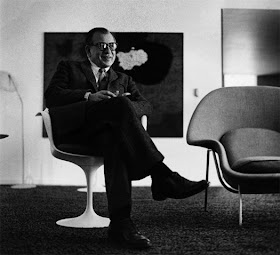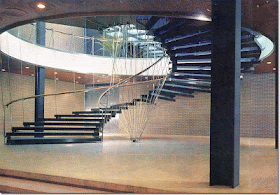Eero Saarinen (August 20, 1910 – September 1, 1961) was one of my favourite mid-century designers.
Hailing from Finland, Saarinen emigrated to the US when he was thirteen, and studied furniture design and sculpture at the Cranbrook Academy of Art in Michigan, where his father was a teacher. His fellow students included Charles and Ray Eames, and Florence Knoll (née Schust).
 |
| Eero Saarinen c. 1937 via |
He was also an architect and interior designer, having studied architecture in both Paris and at Yale, and loved simple, modern designs with sweeping curves. Such as this.
 |
| reception desk by Saarinen via |
This is the reception desk at the General Motors Technical Center, designed by Saarinen, with construction beginning in 1949. Completed in 1955 it was opened by President Dwight D. Eisenhower on May 16, 1956. It cost a mammoth US$100,000,000 to build, and included 11 miles (18 km) of roads, 1.1 miles (1.8 km) of tunnels, 25 main buildings, a water tower and 22-acre (89,000 m2) lake on a 300 acre property.
 |
| General Motors Technical Center in Warren. via |
Below - clockwise from the top left: Stairs in the Administration Building. The main entrance lobby can be seen on the ground floor. The upstairs on this end of the building had a gallery area at the top of the stairs. The Administration Building cafeteria is to the right, and to the left were several executive offices.
The Technical Centre also featured this huge spiral staircase that was supported using an innovative and complex stainless steel rod suspension system.
In 1986 The American Institute of Architects honored it as the most outstanding architectural project of its era. He was criticized by some of his peers as having no style - but looking at his other work that is clearly not the case.
 |
| TWA Terminal at Idlewild (now JFK) Airport, Eero Saarinen, New York, 1962 via |
 |
| Eero Saarinen, Dulles International Airport, Chantilly, Virginia, 1958 via |
Although he designed over thirty buildings, Saarinen is probably best remembered for his furniture - the
"Womb" chair and ottoman (1948), the "Womb" settee (1950), side and arm chairs (1948–1950), and his most famous "Tulip" or "Pedestal" group (1956), which featured side and arm chairs, dining, coffee and side tables, as well as a stool. All of his furniture was taken into production by the Knoll furniture company, founded by Hans Knoll (who had married Saarinen's friend Florence Schust) and is still produced by the
Knoll company today.
 |
| Eero Saarinen, c. 1958 in his Tulip Chair via |
Here in Australia he is also known for being the main reason that Danish architect Jørn Utzon's design was chosen for the Sydney Opera House - Utzon's design had been discarded by other's, but Saarinen put it again in front of the committee when he was appointed, and the rest is history.
Saarinen died at the extremely young age of 51, while undergoing an operation for a brain tumor. He left behind his second wife Aline Bernstein Louchheim and their son Eames, and his two children from his first marriage, Eric and Susan. Partners at his architectural firm, Eero Saarinen and Associates, posthumously executed some of his most high-profile works.
 |
| Eero and Aline Saarinen (à droite) Vassar, Poughkeepsie, NY, 1954-1958 via |
Happy Birthday Eero,
♥ Deb












Hello Deb,
ReplyDeleteYour blog is so great with so much history! I have nominated you for a Liebster award (means dearest in German)! You can find the details in my blog http://papermothballvintage.blogspot.com/
Thank you,
Laura
Thankyou Laura. I have just recently participated in this - I was just waiting for some sort of confirmation but maybe I'll just put the banner anyway. you can read about that process at
Deletehttp://debyclark.blogspot.com.au/2013/07/a-blog-award-nomination.html
I will check out your blog though!